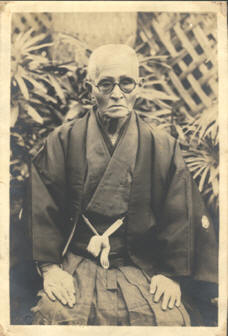
SENSEI
Those who made the road before
Chotoku K(i)yan
Isshinryu lineage: Chotoku Kiyan → Tatsuo Shimabukuro
Chotoku Kyan was born in December 1870 (Meiji 3) at Shun Gihomura as the third son of Chofu Kyan the eleventh generation of King ShoSei under the fourth period of King ShoSei at Ryukyu. His father was the important retainer of the Lord Shotai who lived in Tokyo as the final King of the Ryukyus. His father was well trained in the art of Okinawa te and was an authority of both the Chinese and Japanese classics. Choto Kyan was taken to Tokyo by his father at the age of 13. There he studied the Chinese Classics at the Nisho School until he was 16 years old. He was small and weak compared to his father. Chofu Kyan worried about his son's physical condition so he trained his son in the art of Sumo Wrestling.
After Chofu Kyan's tour of service in Japan ended, he and his son Chotoku went back to Okinawa and lived in a small house at Hoko between Shun and Mawashi. When Chotoku became 20 years old, his father asked the great Shuri-te masters Sobi Matsumura and Ankoh Itosu of Shuri Yamakura-mura to teach his son Shuri-te. Chofu also sought the guidance of the great Tomari-te master Koken Oyadomari to help round off Chotoku's training and physical conditioning.
Chotoku, with his tenacity and dedication trained extremely hard and by the age of 30 earned the nickname Kiyabu Miisho. Miisho was the title given to those who excel in the art of Te. Chotoku was not only a quick learner, he demonstrated an intellectual capability to further develop the art he was taught. Chotoku believed that skill in Te was a matter of 30% physical training and 70% skill, strategy and intelligence. To supplement his hard training in the empty hand method, Chotoku took a special interest in the use of the makiwara. He used it to harden his fists and strengthen his legs and kicks. He used two types of makiwara, a flexible one for punching and a round, stable one for kicking. Chotoku is said to have developed over 50 ways of punching and kicking the makawara.
Chotoku Kyan was also called from "Chan Mi-gwa" (small eyed) Kyan. It was a fact that Chotoku suffered from a astigmatism and his eyes were some what smaller then his rather small face. Chotoku taught eight kata; Kusanku of Chatanyara, Ananku which he brought back from Formosa (Taiwan), Seisan and Gojushiho of Matsumura, Chinto of Matsumora, Passai of Oyadomari (includes Passai-Sho & Passai-Dai), Wansu of Maeda. Chotoku had trained in the Naifanchi of Matsumura but chose not to teach them as part of his way.
After the abolition of clans and establishment of perfectures in Japan most people of the ex-military class lost their jobs. This also brought serious problems of how to make a living to Chotoku Kyan. Since he had property from the family Sho in Dokutani-mura, he moved there to do become involved in agriculture and work as a wagon master. There he continued to practice karate under Kitaya Yara (Chantanyara). During that period he mastered the Kusanku Kata. Later, he built his house near the Hisha Bridge of Dokutani-mura and proceeded to teach karate (formally called Te) to the people of the village at Kadena Police Office and the Agricultural School. This is when Zenryo Shimabukuro, Tatsuo Shimabukuro, Eizo Shimabukuro, Shoshin Nagamine and Tsuyoshi Chitosei trained.
Having taught Karate for many years, Chotoku Kyan, while living in Ishikawa-shi of Chuto-gun, passed away on September 20, 1945, at the age of 76 because of a food shortage. Chotoku Kyan remains a great influence on the many systems of Shorin-Ryu Karate-Do taught internationally today.